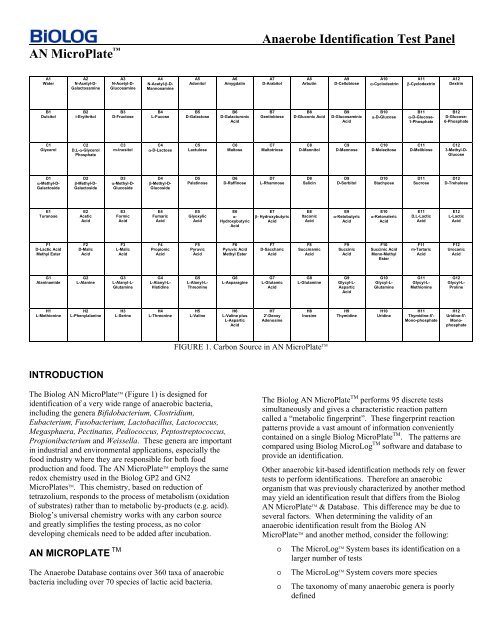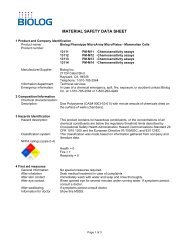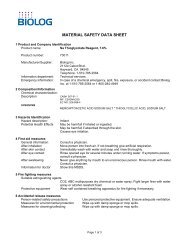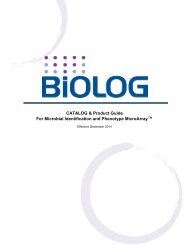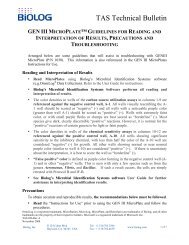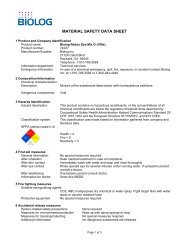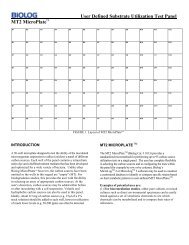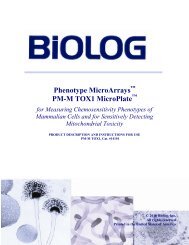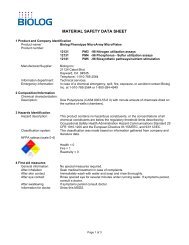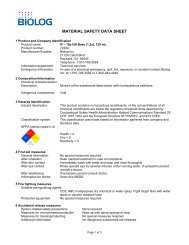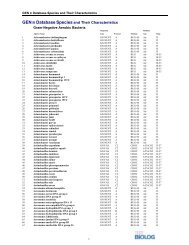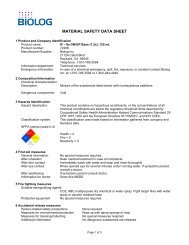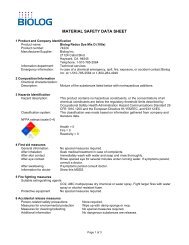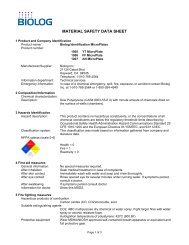Anaerobe Identification Test Panel AN MicroPlate™ - Biolog Inc.
Anaerobe Identification Test Panel AN MicroPlate™ - Biolog Inc.
Anaerobe Identification Test Panel AN MicroPlate™ - Biolog Inc.
You also want an ePaper? Increase the reach of your titles
YUMPU automatically turns print PDFs into web optimized ePapers that Google loves.
<strong>AN</strong> MicroPlate <br />
A1<br />
Water<br />
B1<br />
Dulcitol<br />
C1<br />
Glycerol<br />
D1<br />
α-Methyl-D-<br />
Galactoside<br />
E1<br />
Turanose<br />
F1<br />
D-Lactic Acid<br />
Methyl Ester<br />
G1<br />
Alaninamide<br />
H1<br />
L-Methionine<br />
A2<br />
N-Acetyl-D-<br />
Galactosamine<br />
B2<br />
i-Erythritol<br />
C2<br />
D,L-α-Glycerol<br />
Phosphate<br />
D2<br />
β-Methyl-D-<br />
Galactoside<br />
E2<br />
Acetic<br />
Acid<br />
F2<br />
D-Malic<br />
Acid<br />
G2<br />
L-Alanine<br />
H2<br />
L-Phenylalanine<br />
INTRODUCTION<br />
INTRODUCTION<br />
The <strong>Biolog</strong> <strong>AN</strong> MicroPlate TM (Figure 1) is designed for<br />
identification of a very wide range of anaerobic bacteria,<br />
including the genera Bifidobacterium, Clostridium,<br />
Eubacterium, Fusobacterium, Lactobacillus, Lactococcus,<br />
Megasphaera, Pectinatus, Pediococcus, Peptostreptococcus,<br />
Propionibacterium and Weissella. These genera are important<br />
in industrial and environmental applications, especially the<br />
food industry where they are responsible for both food<br />
production and food. The <strong>AN</strong> MicroPlate TM employs the same<br />
redox chemistry used in the <strong>Biolog</strong> GP2 and GN2<br />
MicroPlates TM . This chemistry, based on reduction of<br />
tetrazolium, responds to the process of metabolism (oxidation<br />
of substrates) rather than to metabolic by-products (e.g. acid).<br />
<strong>Biolog</strong>’s universal chemistry works with any carbon source<br />
and greatly simplifies the testing process, as no color<br />
developing chemicals need to be added after incubation.<br />
<strong>AN</strong> MICROPLATE TM<br />
A3<br />
N-Acetyl-D-<br />
Glucosamine<br />
B3<br />
D-Fructose<br />
C3<br />
m-Inositol<br />
D3<br />
α-Methyl-D-<br />
Glucoside<br />
E3<br />
Formic<br />
Acid<br />
F3<br />
L-Malic<br />
Acid<br />
G3<br />
L-Alanyl-L-<br />
Glutamine<br />
H3<br />
L-Serine<br />
A4<br />
N-Acetyl-β-D-<br />
Mannosamine<br />
B4<br />
L-Fucose<br />
C4<br />
α-D-Lactose<br />
D4<br />
β-Methyl-D-<br />
Glucoside<br />
E4<br />
Fumaric<br />
Acid<br />
F4<br />
Propionic<br />
Acid<br />
G4<br />
L-Alanyl-L-<br />
Histidine<br />
H4<br />
L-Threonine<br />
A5<br />
Adonitol<br />
B5<br />
D-Galactose<br />
C5<br />
Lactulose<br />
D5<br />
Palatinose<br />
E5<br />
Glyoxylic<br />
Acid<br />
F5<br />
Pyruvic<br />
Acid<br />
G5<br />
L-Alanyl-L-<br />
Threonine<br />
H5<br />
L-Valine<br />
The <strong>Anaerobe</strong> Database contains over 360 taxa of anaerobic<br />
bacteria including over 70 species of lactic acid bacteria.<br />
A6<br />
Amygdalin<br />
B6<br />
D-Galacturonic<br />
Acid<br />
C6<br />
Maltose<br />
D6<br />
D-Raffinose<br />
E6<br />
α-<br />
Hydroxybutyric<br />
Acid<br />
F6<br />
Pyruvic Acid<br />
Methyl Ester<br />
G6<br />
L-Asparagine<br />
H6<br />
L-Valine plus<br />
L-Aspartic<br />
Acid<br />
<strong>Anaerobe</strong> <strong>Identification</strong> <strong>Test</strong> <strong>Panel</strong><br />
A7<br />
D-Arabitol<br />
B7<br />
Gentiobiose<br />
C7<br />
Maltotriose<br />
D7<br />
L-Rhamnose<br />
E7<br />
β- Hydroxybutyric<br />
Acid<br />
F7<br />
D-Saccharic<br />
Acid<br />
G7<br />
L-Glutamic<br />
Acid<br />
H7<br />
2'-Deoxy<br />
Adenosine<br />
A8<br />
Arbutin<br />
B8<br />
D-Gluconic Acid<br />
C8<br />
D-Mannitol<br />
D8<br />
Salicin<br />
E8<br />
Itaconic<br />
Acid<br />
F8<br />
Succinamic<br />
Acid<br />
G8<br />
L-Glutamine<br />
H8<br />
Inosine<br />
FIGURE 1. Carbon Source in <strong>AN</strong> MicroPlate TM<br />
A9<br />
D-Cellobiose<br />
B9<br />
D-Glucosaminic<br />
Acid<br />
C9<br />
D-Mannose<br />
D9<br />
D-Sorbitol<br />
E9<br />
α-Ketobutyric<br />
Acid<br />
F9<br />
Succinic<br />
Acid<br />
G9<br />
Glycyl-L-<br />
Aspartic<br />
Acid<br />
H9<br />
Thymidine<br />
A10<br />
α-Cyclodextrin<br />
B10<br />
α-D-Glucose<br />
C10<br />
D-Melezitose<br />
D10<br />
Stachyose<br />
E10<br />
α-Ketovaleric<br />
Acid<br />
F10<br />
Succinic Acid<br />
Mono-Methyl<br />
Ester<br />
G10<br />
Glycyl-L-<br />
Glutamine<br />
H10<br />
Uridine<br />
A11<br />
β-Cyclodextrin<br />
B11<br />
α-D-Glucose-<br />
1-Phosphate<br />
C11<br />
D-Melibiose<br />
D11<br />
Sucrose<br />
E11<br />
D,L-Lactic<br />
Acid<br />
F11<br />
m-Tartaric<br />
Acid<br />
G11<br />
Glycyl-L-<br />
Methionine<br />
H11<br />
Thymidine-5'-<br />
Mono-phosphate<br />
A12<br />
Dextrin<br />
B12<br />
D-Glucose-<br />
6-Phosphate<br />
C12<br />
3-Methyl-D-<br />
Glucose<br />
D12<br />
D-Trehalose<br />
E12<br />
L-Lactic<br />
Acid<br />
F12<br />
Urocanic<br />
Acid<br />
G12<br />
Glycyl-L-<br />
Proline<br />
H12<br />
Uridine-5'-<br />
Monophosphate<br />
The <strong>Biolog</strong> <strong>AN</strong> MicroPlate TM performs 95 discrete tests<br />
simultaneously and gives a characteristic reaction pattern<br />
called a “metabolic fingerprint”. These fingerprint reaction<br />
patterns provide a vast amount of information conveniently<br />
contained on a single <strong>Biolog</strong> MicroPlate TM . The patterns are<br />
compared using <strong>Biolog</strong> MicroLog TM software and database to<br />
provide an identification.<br />
Other anaerobic kit-based identification methods rely on fewer<br />
tests to perform identifications. Therefore an anaerobic<br />
organism that was previously characterized by another method<br />
may yield an identification result that differs from the <strong>Biolog</strong><br />
<strong>AN</strong> MicroPlate TM & Database. This difference may be due to<br />
several factors. When determining the validity of an<br />
anaerobic identification result from the <strong>Biolog</strong> <strong>AN</strong><br />
MicroPlate TM and another method, consider the following:<br />
o The MicroLog TM System bases its identification on a<br />
larger number of tests<br />
o The MicroLog TM System covers more species<br />
o The taxonomy of many anaerobic genera is poorly<br />
defined
Various methods have different numbers and types of<br />
organisms within their database. Figure 2 presents several<br />
popular kit-based methods. The <strong>Biolog</strong> <strong>AN</strong> MicroPlate TM has<br />
a much larger number of tests, which provides greater<br />
fingerprint discrimination and a larger database.<br />
Manufacturer Number of Anaerobic<br />
Taxa in Database<br />
<strong>Biolog</strong>, <strong>Inc</strong><br />
MicroLog TM<br />
bioMérieux<br />
Vitek ®<br />
bioMérieux<br />
API 20A ®<br />
BBL ® Crystal <br />
Innovative<br />
Diagnostic<br />
Systems, <strong>Inc</strong>.<br />
RapID <strong>AN</strong>A II<br />
Part# 00A 006, Rev. B, July 2007<br />
Number of <strong>Test</strong>s<br />
Used for <strong>Identification</strong><br />
366 95<br />
84 28<br />
77 20<br />
107 28<br />
96 18<br />
FIGURE 2. Comparison of Commercial<br />
<strong>Test</strong> Kits for <strong>Anaerobe</strong>s<br />
Beyond the number of tests provided to detect an unknown,<br />
some methods rely primarily on fermentation of sugars. This<br />
approach to identification does not provide the necessary<br />
environment for every organism of interest. Many bacteria<br />
cannot utilize sugars via a fermentative process and are missed<br />
or react weakly with these methods.<br />
The state of anaerobic taxonomy further exacerbates the<br />
limitations of other methods. The taxonomy of anaerobic<br />
bacteria is based on much less information and is not as<br />
developed as aerobic taxonomy. For example, the<br />
classification of Clostridium botulinum is based on the<br />
organism’s ability to produce one or more forms of botulinum<br />
neurotoxin. Five morphologically distinct organisms have<br />
been shown to produce this neurotoxin. According to current<br />
anaerobic taxonomy all five of these organisms should be<br />
classified (identified) as C. botulinum. Strains of these species<br />
which do not produce the toxin, are not classified as nontoxigenic<br />
C. botulinum, but would be called, for example C.<br />
sporogenes. If this same criterion were applied to aerobic<br />
taxonomy then all Shiga toxin producing species of enteric<br />
bacteria would be assigned to the genus Shigella.<br />
<strong>Anaerobe</strong> <strong>Identification</strong> <strong>Test</strong> <strong>Panel</strong><br />
PROCEDURE FOR USING <strong>AN</strong> MICROPLATES TM<br />
The procedure is fast and simple, involving only 5 steps, and<br />
requiring only 2 to 3 minutes hands-on time per sample.<br />
1) A pure culture of a bacterium is grown on a <strong>Biolog</strong><br />
Universal <strong>Anaerobe</strong> agar plate (<strong>Biolog</strong> Catalog #<br />
70007 for a 500g jar or 71007 for pre-poured plates)<br />
in either an anaerobic chamber or anaerobic jar until<br />
enough growth is present to prepare a suspension.<br />
2) The bacteria are swabbed from the surface of the agar<br />
plate, and suspended to a specified density in <strong>AN</strong><br />
Inoculating Fluid (<strong>Biolog</strong> Catalog # 72007). This<br />
step may be performed in an anaerobic chamber.<br />
3) 100 µl of bacterial suspension is pipetted into each<br />
well of the <strong>AN</strong> MicroPlate TM (<strong>Biolog</strong> Catalog # 1007)<br />
under aerobic conditions.<br />
4) The MicroPlate TM is incubated in an anaerobic jar<br />
with a hydrogen free anaerobic atmosphere at 35 o C<br />
for 20-24 hours. (A hydrogen free anaerobic<br />
atmosphere can be produced by either the Oxoid<br />
AnaeroGen TM or the Mitsubishi AnaeroPak TM System,<br />
Pack-Anaero.)<br />
5) The MicroPlates TM are removed from the anaerobic<br />
container and read either visually or with the <strong>Biolog</strong><br />
MicroStation TM Reader, compared to the <strong>AN</strong> Database<br />
(<strong>Biolog</strong> catalog # 22607D), and a result is<br />
determined.<br />
<strong>AN</strong>AEROBE DATABASE<br />
The <strong>Biolog</strong> <strong>AN</strong> database has the largest database of any kitbased<br />
method. This superior product will be an invaluable<br />
addition to your anaerobic laboratory. Some highlights are:<br />
o Bifidobacterium, usually called Bifidus, which could<br />
not formerly be speciated by ID kits, can now be<br />
identified with this product.<br />
o The genera Pectinatus and Megasphaera are not<br />
covered in other anaerobic test kits but can be<br />
identified with the MicroLog TM <strong>AN</strong> database.<br />
o The MicroLog TM database has 43 Lactobacillus spp.,<br />
and over 70 species of lactic acid bacteria. Other kit<br />
based methods cover approximately 7 species.<br />
For more information, contact us using the information below<br />
21124 Cabot Blvd. Hayward, CA 94545 Telephone: 510-785-2564 Fax: 510-782-4639 www.biolog.com


